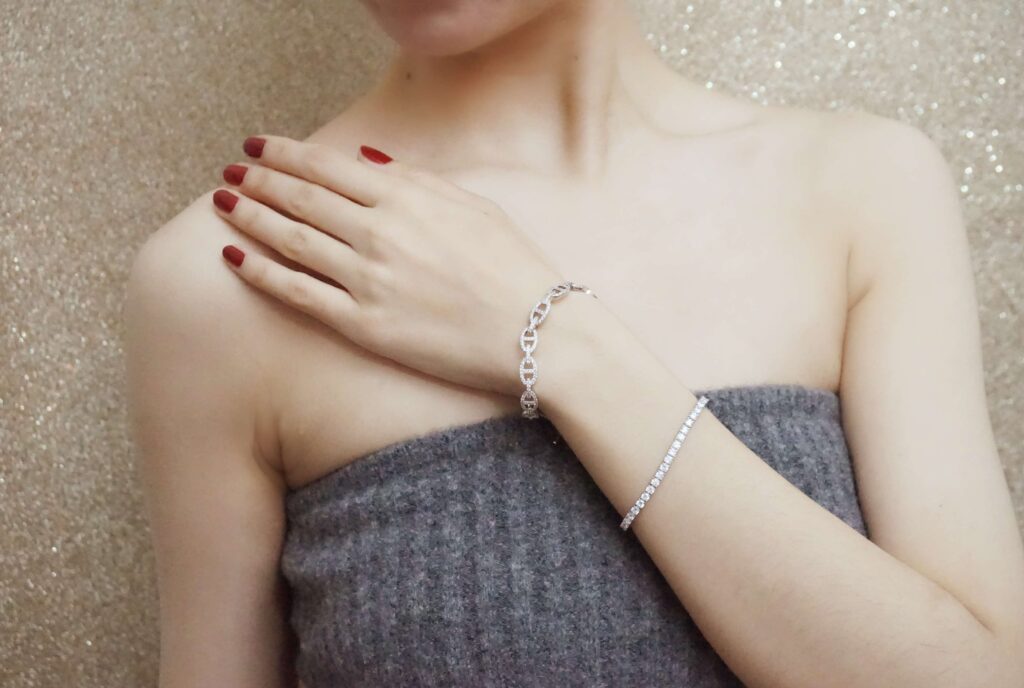Sterling Silver VS. White Gold
When it comes to choosing the perfect piece of jewelry, the age-old question of white gold vs sterling silver often arises. Both precious metals have their unique charms, but which one is the better choice for you? Let’s dive into the intricate world of these two metals and discover which one reigns supreme.

White Gold: The Elegant Contender
White gold is an exquisite blend of pure gold and other metals such as palladium, silver, or nickel. This alloy not only gives the metal a stunning silvery-white appearance but also enhances its durability and scratch resistance.
Pros of White Gold:
- Luxurious appeal: White gold’s lustrous shine and elegant appearance make it a popular choice for engagement rings and fine jewelry.
- Hypoallergenic options: If you opt for a white gold alloy with palladium instead of nickel, it is less likely to cause allergies.
- Durability: The added metals in white gold make it more durable and scratch-resistant than sterling silver.
Cons of White Gold:
- Requires maintenance: White gold is often plated with rhodium to retain its shine, which can wear off over time and require re-plating.
- More expensive: Due to its gold content, white gold is generally more expensive than sterling silver.
Sterling Silver: The Versatile Warrior
Sterling silver, on the other hand, is an alloy composed of 92.5% pure silver and 7.5% other metals, typically copper. This combination gives sterling silver its strength and versatility, making it a popular choice for various jewelry types and styles.
Pros of Sterling Silver:
- Affordability: Sterling silver is typically less expensive than white gold, making it an accessible option for all budgets.
- Versatility: Its adaptable nature allows for a wide range of designs, from delicate pieces to bold statement jewelry.
- Easy to maintain: Sterling silver can be easily polished and cleaned at home to restore its original shine.
Cons of Sterling Silver:
- Tarnishing: Over time, sterling silver can tarnish due to exposure to air and moisture, requiring regular cleaning.
- Less durable: Sterling silver is more prone to scratches and dents compared to white gold.
The Verdict: White Gold or Sterling Silver?
In the battle of white gold vs sterling silver, the winner ultimately depends on your personal preferences and priorities. If you’re seeking a luxurious, durable option for a special piece of jewelry like an engagement ring, white gold may be the ideal choice. However, if you’re looking for a more budget-friendly and versatile metal, sterling silver offers a fantastic alternative.
In the end, both precious metals have their unique qualities and allure, and each can make a beautiful addition to your jewelry collection. Whether you choose white gold or sterling silver, you’ll surely shine in the dazzling world of precious metals.

FAQs about white gold and sterling silver
Sterling silver is less durable but more affordable. White gold is more durable but comes with a higher price tag. Think about the type of piece you’d like to by and how often it will be worn when making your decision.
White gold is high-quality, affordable and resistant to tarnishing, making it an attractive alternative to visually similar metals like platinum and silver.
This precious metal is one of the few that won’t tarnish or rust over time. Since it’s non-reactive, it will resist corrosion for a long time and can be worn in the shower without any fear of tarnishing. Whether it’s regular gold, white gold, or rose gold, it’s safe in the shower.
One of the biggest differences, when you’re weighing white gold or silver, is clearly the price. Silver is a much cheaper material, and is quite beautiful if you are on a budget and looking for quality elegant sterling silver jewelry. White gold costs $23.86 per gram, while sterling silver costs only $0.59 per gram.
